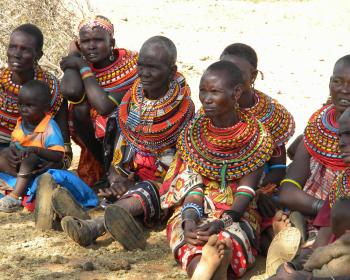The Turkana are nomadic pastoralists who live in the desert regions of northwestern Kenya. These people were one of many affected by a severe drought in 1979 and 1980. Although the famine which resulted from the sharp drop in food production was dramatized by the international press, insecurity of food availability is characteristic of pastoral production systems. The following discussion examines how the Turkana cope with the uncertainty associated with seasonal, annual and interhomestead variation in food production.
The Ngisonyoka, one group of Turkana pastoralists, inhabit an area of approximately 10,000 sq. km. in the southwestern portion of Turkana District. The climate of the area is classified as arid to semi-arid with high ambient temperatures and a two to three month "rainy season." Although the Turkana identify a specific time of the year as the "rainy season" (akiporo), usually corresponding to the months of March to May, data demonstrate that the amount it rains, where, and for how long varies tremendously in the area.
Livestock Management
The Ngisonyoka practice no agriculture and live exclusively off the products of their livestock - milk, meat, blood and skins. The inventory of goods acquired with money from the sale of livestock is small, consisting primarily of maize meal, sugar, tobacco, tea leaves, rubber tire sandals, and cloth.
Five species of livestock are kept: camels, cattle, goats, sheep and donkeys. Each species has different food and water requirements. Camels are browsers; sheep, cattle and donkeys are grazers; and goats can be classified as either. Browsers must include a large amount of leafy vegetation in their diet, while grazers favor grasses.
The Turkana live in small households consisting of a man, his wives, their children and possibly some dependent women. This social unit is referred to as an awi. Household size varies considerably according to wealth, but averages about 20-25 people. All livestock are "owned" by the male head of the household, but within the awi they are allocated to women. The number of animals allocated depends upon a woman's status within the family and the number of children which must be fed. Women milk those animals which are allocated to them; the offspring of these livestock will be the basis of their sons' future herds.
Decisions relating to livestock management rest with the household head, or with the herd manager if the herd is separate from the awi. This allows each household head to make decisions based on who can work, herd size, social obligations, and perceptions of the environment and proper herd management.
The climate imposes constraints on the available techniques of livestock management. Because precipitation is extremely variable, there is a high degree of variation in forage quality and quantity, both between seasons and between years.
One technique used by the Ngisonyoka to exploit an environment where the availability of food is inconsistent, sparse, and scattered is the management of herds composed of many species. As food diminishes with the onset of the dry season, the Turkana may divide their animals into different herds. Thus a man may have milking and non-milking herds of camels, cattle, and sheep and goats - sheep and goats are herded together. In the wet season the milking and non-milking herds are joined, with all the people and animals together in one awi. As the dry season progresses, non-milking herds may be split off from the awi to pursue different ranges. These non-milking herds are managed by young men who, for the most part, act as the principal decision-makers while the herd is separated.
The second important technique used to manage livestock is mobility. The pastoral Ngisonyoka have no permanent settlements. The majority of the people and most of the milking animals live in the major homestead which remains in the plains throughout the year but moves frequently as forage and water resources are depleted. Non-milking stock are often moved to the foothills or slopes of the mountains where the vegetation lasts longer than it does on the plains.
Families with large herds may be forced to move more frequently than those with small ones. Some families may be constrained by labor shortages, thus unable to manage a number of different herds. Families with a dominance of one species of livestock may differ in their movements from families whose herds are dominated by another species. The pattern of movements therefore varies seasonally, annually, and among individual herd owners.
The pattern of movement of individual herd owners also proved to be highly complex. One example of this complexity is provided in figure 2(*). This map displays the movements of one Turkana herdowner over the course of one year. Reasons for movement were principally ecological but also included changes of location for reasons of security and proximity to friends and relatives.
Even though the Ngisonyoka are extremely mobile and can move their livestock to the locations which they feel are the "best," livestock productivity varies. Milk yields for all animal species showed marked seasonal, annual and inter-awi differences. At the height of the dry season, milk might contribute little to the total food supply, while during a good wet season milk may supply the family with all its food.
* A detailed description of one man's pattern of movement over a two-year period can be found in McCabe 1983.
The effect of the drought and the various livestock species' ability to recover was also reflected in the data for milk yields. Cattle were the most severely stressed species during the drought, and provided almost no milk to the human population for the entire drought year. Camels were the most reliable milkers, followed by goats.
The Turkana keep multiple species herds in order to buffer the variations in the quality and distribution of vegetal resources. However, ecological diversity is not enough to insure the survival of the family. In times of stress the Turkana utilize a system of social ties, obligations and rights which they build up over a lifetime. Kinship provides an individual with many potential supporters. Important social relationships are reconfirmed periodically via the exchange of livestock between individuals, either kinsmen or friends. Thus each herdowner will have a social network which is unique. Turkana social organization allows flexibility in the formation of these social networks which provide an individual with access to productive livestock in times of shortage.
The institutions mentioned above demonstrate the ability of the pastoral family to remain viable over time. There is another social institution which allows those members of the society, who for one reason or another, have lost most or all of their livestock, to remain in the pastoral system. Among the Turkana, food must be shared with relatives who are asking for it, unless it causes shortages for a man's immediate family. Thus, most wealthy and some not-so-wealthy families have acquired a number of dependents which share the "surplus" of the richer family. The result of this shifting of people around within the system allows more people to live off the limited resource base available to the Turkana.
Conclusion
Although management techniques and social institutions buffer the effects of seasonal and annual variation in food availability, they cannot guarantee survival through a drastic, sustained climatic shift such as the 1979-81 drought. The social institutions which maintained dependents began to break down during the drought. As the drought progressed more people were forced out of the pastoral sector. Some of these destitute individuals were able to support themselves by working as unskilled laborers in towns, but many more began to look to international aid agencies for food relief.
The ability of the people to utilize fully the available resources has far-reaching implications, especially where development is concerned. The Turkana system of social organization has developed in such a way that it allows many people to live in this desert region. This is accomplished through social obligations focusing on the sharing of food, and to some extent livestock and labor. Livestock development, by contrast, emphasizes the number of animals, not people, and imposes restrictions with regard to the sharing of pastoral resources. This could lead to a breakdown of the system of social ties and obligations which has enabled generations of Turkana pastoralists to cope with the stresses imposed by living in a harsh and always unpredictable environment.
Article copyright Cultural Survival, Inc.



